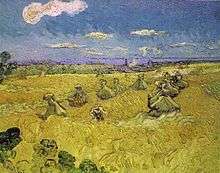French standard sizes for oil paintings

Harvest near Auvers (1890), a size 30 canvas, by Vincent van Gogh.
French standard sizes for oil paintings refers to a series of different sized canvases for use by artists. The sizes were fixed in the 19th century. Most artists, not only French, used this standard, as it was supported by the main suppliers of artist materials. Only some contemporary artist material suppliers continue to use these standards today, as most artists no longer differentiate canvas sizes by subject.
The main separation from size 0 (toile de 0) to size 120 (toile de 120) is divided in separate runs for faces/portraits (figure), landscapes (paysage) and marines (marine) which more or less keep the diagonal. That is, a figure 0 corresponds in height to a paysage 1 and a marine 2.[1]
| Numéro | Figure (cm) | Paysage (cm) | Marine (cm) |
|---|---|---|---|
| 0 | 18 x 14 | 18 x 12 | 18 x 10 |
| 1 | 22 x 16 | 22 x 14 | 22 x 12 |
| 2 | 24 x 19 | 24 x 16 | 24 x 14 |
| 3 | 27 x 22 | 27 x 19 | 27 x 16 |
| 4 | 33 x 24 | 33 x 22 | 33 x 19 |
| 5 | 35 x 27 | 35 x 24 | 35 x 22 |
| 6 | 41 x 33 | 41 x 27 | 41 x 24 |
| 8 | 46 x 38 | 46 x 33 | 46 x 27 |
| 10 | 55 x 46 | 55 x 38 | 55 x 33 |
| 12 | 61 x 50 | 61 x 46 | 61 x 38 |
| 15 | 65 x 54 | 65 x 50 | 65 x 46 |
| 20 | 73 x 60 | 73 x 54 | 73 x 50 |
| 25 | 81 x 65 | 81 x 60 | 81 x 54 |
| 30 | 92 x 73 | 92 x 65 | 92 x 60 |
| 40 | 100 x 81 | 100 x 73 | 100 x 65 |
| 50 | 116 x 89 | 116 x 81 | 116 x 73 |
| 60 | 130 x 97 | 130 x 89 | 130 x 81 |
| 80 | 146 x 114 | 146 x 97 | 146 x 89 |
| 100 | 162 x 130 | 162 x 114 | 162 x 97 |
| 120 | 195 x 130 | 195 x 114 | 195 x 97 |
References
- ↑ Haaf, Beatrix (1987), "Industriell vorgrundierte Malleinen. Beiträge zur Entwicklungs-, Handels- und Materialgeschichte", Zeitschrift für Kunsttechnologie und Konservierung, 1: 7–71
This article is issued from Wikipedia - version of the 5/26/2016. The text is available under the Creative Commons Attribution/Share Alike but additional terms may apply for the media files.